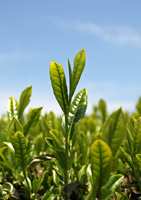|
High-resolusion image
In a world first, Suntory Global Innovation Center Limited and Shizuoka University identified two UDP-glycosyltransferases (UGTs) that form β-primeveroside, a diglycoside responsible for the stable storage of aroma compounds in tea plants (Camellia sinensis), and clarified the mechanism by which aroma compounds are stored in tea plant cells. This research was conducted jointly with the Suntory Foundation for Life Sciences, Yamaguchi University, and Kobe University.
The findings of the study have been published on the online version of International journal Plant Physiology on June 1, 2015, and will soon be printed in that journal.
▼ Title
“Volatile glycosylation in tea plants: Sequential glycosylations for the biosynthesis of aroma β-primeverosides are catalyzed by two Camellia sinensis glycosyltransferases”
▼ Joint Research Group
The research was led by Toshiyuki Ohnishi Ph.D.(associate professor, Graduate School of Agriculture, Shizuoka University) and Eiichiro Ono Ph. D. (researcher, Suntory Global Innovation Center Limited), and it was conducted jointly with the Suntory Foundation for Life Sciences, Yamaguchi University, and Kobe University.
[Background]
Tea is considered to be one of the big three non-alcoholic beverages.1 Green tea, oolong tea, and black tea are very popular around the world (in 2012, 3.9 million tons were produced worldwide, 85 thousand tons of which were produced in Japan).2 A key element that determines a tea’s quality is its aroma. Green tea, oolong tea, and black tea each have their own characteristic aromas, but they are all manufactured from tea plants by different procedures.
Tea plants store aroma compounds stably in the water-soluble diglycoside form called β-primeverosides. While β-primeveroside of aromas (non-volatiles) does not produce aroma in and of itself, a diglycoside-specific glycosidase called β-primeverosidase, which is also present in the tea plants, cleaves this diglycoside (primeverose) into aroma compounds (volatiles) and sugar moiety, and liberates the aroma compounds, thereby releasing aroma. The activity of the β-primeverosidase is controlled through the special manufacturing processes for green, oolong, and black tea, resulting in tea beverages with a rich variety of aromas. However, until now it was totally unknown how β-primeverosides of aromas are produced in tea plants.
Given this situation, the research team focused on the process by which β-primeverosides are produced in an attempt to elucidate the mechanism of aroma storage.
| [Overview of Research] |
| 1-1 |
The team used Yabukita tea leaves, the major tea cultivar used in Japanese teas, and comprehensively surveyed candidate glycosyltransferase (UGT) genes responsible for conjugating aroma compounds with the first sugar (glucose) based on the genetic information. |
| 1-2 |
The team analyzed protein (enzyme) of the candidate UGT genes identified in 1-1 to determine its enzymatic activity. Among the candidate genes, the team found an enzyme, which converts aroma into aroma glucoside by conjugating a glucose from UDP-glucose. Thus, this enzyme was named CsGT1 (see Figure 1). |
| 2-1 |
The team conducted enzyme purification from fresh leaves based on the enzymatic activity converting aroma glucoside into primeveroside by conjugating the second sugar (xylose). This purification process successfully identified a single enzyme, which exhibits the activity. Thus, this enzyme was named CsGT2 (see Figure 2). |
| 2-2 |
The team explored the genes responsible to the CsGT2 based on the partial amino acid sequence, and found a candidate UGT gene encoding CsGT2 using next generation sequencer (NGS). The team analyzed protein responsible to the candidate gene and found the activity converting aroma glucoside into primeveroside by conjugating a xylose from UDP-xylose. Thus, the candidate UGT gene was confirmed to encode CsGT2. |
| 3-1 |
The team revealed that the CsGT1 and CsGT2 genes are highly expressed in the young fresh leaves used in tea manufacturing and thus, predict that the storage of aroma compounds occurs proactively in young leaves. In addition, the team found the presence of UGT genes with very similar sequences to CsGT1 and CsGT2 in many plants, suggesting that the aroma storage mechanism by the two distinct UGTs is widely conserved in plants. |


This research elucidated the mechanism for stable storage of aroma compounds by identifying two UGTs that produce β-primeveroside, a diglycosides in tea plants.
[Future Prospects]
The elucidation of the aroma storage mechanism in tea plants offers the following prospects: |
| (1) |
Identifying the varieties, cultivars or parts of tea plants based on the activity of CsGT1 and CsGT2, will facilitate development of new tea products by choosing specific varieties or parts. |
| (2) |
Analyzing temporal regulation of CsGT1 and CsGT2 and environmental factors affecting their activities will help ascertain the best time and suitable parts of the plant to harvest. This knowledge will in turn lead to the new cultivating and processing applications that bring out the aroma of tea. |
| (3) |
CsGT1 and CsGT2 will serve as useful genetic markers for breeding new tea cultivars with focus on aroma. |
Suntory Beverage & Food Limited Group Companies will continue collaboration with Suntory Global Innovation Center with a view to utilizing these research results for the creation of added value in the beverage and food manufacture and retail sector.
| |
1 |
The world’s three big non-alcoholic beverages are coffee, tea, and cocoa. |
| |
2 |
FAOSTAT (Food and Agriculture Organization Corporate Statistical Database) |
Suntory Global Innovation Center Limited website : https://www.suntory.com/sic/
Suntory Beverage & Food Limited website : https://www.suntory.com/sbf/
|




